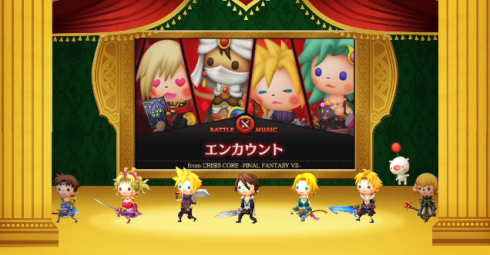Platform: Nintendo 3DS
Publisher: Square-Enix
Genre: Rhythm Game
I was a bit skeptical when I first heard about Theatrhythm. By the time Square-Enix dropped this proverbial hat into the proverbial ring, Guitar Hero and Rock Band had ridden well into the sunset, to the point where they could no longer be seen without a telescope. But I was still drawn to it anyway. I was fond of those other two rhythm games and this one doesn’t require any clunky plastic peripherals. More importantly, I also have a deep love of Final Fantasy’s myriad of over-produced scores. But could a portable system with tiny tinny speakers manage to engross me in the rhythmic experience the same way as, say, an obsessively precise home theater experience? I wanted to find this out.
The core of the game is, of course, the music. Square-Enix has went full-on Nostalgia Celebration Mode here, providing as many as 200 songs from nearly every Final Fantasy game, including obscure titles like Mystic Quest. Most of the tracks are unlocked at the start of the game too so you can overdose on call-backs immediately. The 3DS also perfectly transcribes the audio; there are no ‘As Performed by Nobuo Uematsu’ bullshit covers here and everything plays as originally cut, including pieces from the NES games. You should have no trouble getting instantly transported to those times in your life where you Final Fantasy games were important. And if you haven’t played the series at all? Well, some of the tracks might be interesting enough to go on a hunt for more.
Nostalgia certainly plays a big role in Theatrhythm, but without some decent gameplay it’s just a thirty dollar jukebox. That’s where the rhythm comes in. The player’s objective is to restore a substance called rhythmia to the world because Chaos and Cosmos are arguing about something. Rhythmia is acquired by using adorable chibi versions of Final Fantasy characters to bash in monsters’ heads, traverse through classic fields, or watch full-motion-videos culled from around the multiverse.
All performances are carried out by tapping and sliding around the 3DS screen with the stylus or pressing a button or doing both of those things at once in time with whatever music is playing. As more songs are played, the heroes you’ve selected gain experience points and abilities that allow for better durability in the expert difficulties which, to their credit, are outrageously hard. There is also a quest mode that assembles a smattering of songs to play that end with a siege of some bosses in a dungeon, kind of like a treasure map. I like these quests a lot; it adds a lot of depth to a game that on its face appears to have none. It’s also really exciting when a favorite song comes up; I found myself really wanting to prove my devotion to the Final Fantasy series by beating its ass over and over.
My biggest gripes with the game come down to the nature of the songs and their presentation. Not *all* of my favorites are in this package and are likely only offered via DLC through the Nintendo eShop. Also, several songs (I’m looking directly at you, Dancing Mad) are cut very short to preserve the fundamentally casual aspect of an admittedly casual game. There are also timing issues to contend with, a common problem for all rhythm games. Note latency isn’t always right and the ‘hold then slide’ sections in the field pices sometimes cut off early, resulting in missed Critical hits that can disrupt the music’s flow. StreetPass is incredibly underwhelming–what are the chances someone else will be walking around with this feature turned on, even in the nerdiest of nerdy stores? None, I checked. The game also doesn’t make much use of the 3D qualities of the 3DS, opting to float the track above the action while the paper cut-outs duke it out underneath. These gripes are minor though.
If you ask me, Theatrhythm Final Fantasy Curtain Call is a game that holds up to scrutiny incredibly well. It does this franchise a wonderful service; and even though non-FF gamers probably won’t see much value in it, the nostalgic demographic Square-Enix is clearly targeting have no need to remain skeptical. Give music a chance!

